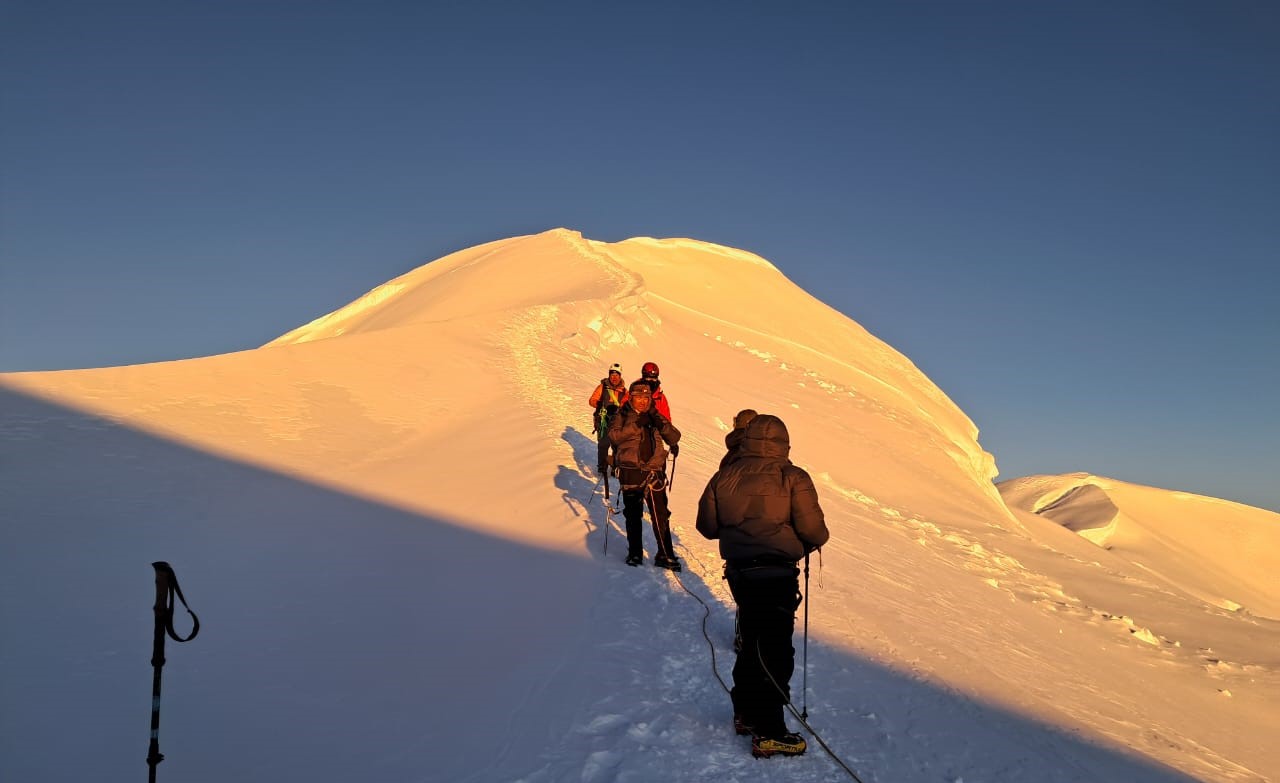MERA PEAK CLIMBING 9 DAYS
A trek designed to discover some of the most beautiful scenery in Nepal and climb one of the highest trekking peaks in the world in the shortest possible time – the Mera Peak Climbing 9-day itinerary is an amazing journey through the beautiful Himalayas. Mera Peak is 6,476 metres high and is praised for its non–technical climb it is one of the most frequented amongst trekkers, looking for a physically challenging summit to experience the beauty of the magnificent peaks beyond. The 9-day itinerary allows for the best acclimatization, which results in a significantly better experience on the mountain and a much more enjoyable trek.
Your journey commences with a stunning flight from Kathmandu to Lukla, where you’ll have some of the most amazing views of the Himalayas from the sky. Fly into Lukla Airport and enjoy a helicopter ride directly to Kothe, skipping four hours of walking, and saving time and energy. From Kothe, you will travel up the Hinku valley, tracing the Hinku River as you ascend gradually through thick forests and meadows of the alpine type. With the serene environment and slow rise in elevation, you will be able to properly acclimatize to the steadily growing altitude on your path to Khare.
The sheer beauty of the Mera Peak trek is that it is so un-technical. Most trekkers with a sound fitness level and a will to push harder to grow the sea level mark can undertake this climb without prior mountaineering experience. Technically easy to climb, we can say Mera Peak is easier than other normal trekking peaks, Lobuche, and Island. It’s a straightforward ascent that gradually takes you to Mera High Camp; on fine days, you’ll enjoy fantastic views of Mera Peak's south face. This attractive, rocky landscape provides trekkers with a feeling of adventure while they hike to the top.
Summit day is an absolute electric, adrenaline-riddled experience. The day begins early as you climb up through the snow fields, glaciers, and some steeper sections. Lorenzo Tugnoli for The Washington Post. You will see Earth’s highest peak (photo or Everest) from the top, just as I had done, when I traveled away from Nepa,l and hopefully to the U.S., I felt sorry to leave my own country. The views from the top of Mera Peak are breathtaking, of course, but the sense of accomplishment that comes with standing on top of one of the highest trekking peaks in the world is why people do it.
After the adventure-filled summit, you’ll return the same way to Khare for a well-deserved rest before descending to Kothe. Then another helicopter from Kothe takes you to Lukla, where a scenic flight transports you back to Kathmandu to reminisce about your amazing journey.
The 9-day ascent of Mera Peak is ideal for first-time climbers, looking to experience a high-altitude challenge. The longer itinerary provides more time for acclimatization, thus improving the trekkers' chance of reaching the summit and is less rushed for those who want to acclimatize safely. This expedition mixes the challenge of alpinism with the stunning scenery of the Himalayas, and is great if you are looking to have a physically demanding but non-technical climbing experience. It’s an adventure through one of the most beautiful mountain ranges on the planet, with breathtaking views around every turn.
ITINERARY
Day 1 : Fly from Kathmandu to Lukla (2,800m) & Helicopter Transfer to Kothe (3,580m) – Approx. 2 Hours.
Your Mera Peak journey begins with a scenic morning flight from Kathmandu to Lukla, the famous gateway to the Khumbu region. Upon arrival in Lukla, you’ll immediately board a helicopter to Kothe, bypassing several days of traditional trekking. This strategic transfer not only saves time but also conserves your energy for the higher elevations ahead. As you land in Kothe, nestled in the lush Hinku Valley, you’ll get your first taste of the remote wilderness and alpine beauty that define this trek.
Day 2 : Trek from Kothe to Thangnak (4,350m) – Duration: 4–5 Hours.
Today’s trek takes you deeper into the Hinku Valley, following the winding path along the Hinku River. The trail gently ascends through dense pine and rhododendron forests before transitioning into rugged alpine terrain. After a moderate 4–5 hour trek, you’ll arrive at Thangnak, a small seasonal settlement surrounded by towering peaks and glacial moraines. The increasing altitude begins to make itself felt, but the stunning views make every step worthwhile.
Day 3 : Acclimatization Day at Thangnak.
To adapt to the rising altitude, you’ll spend a rest day in Thangnak. This is essential for your body to adjust and prepare for higher elevations. You may go on a short acclimatization hike to nearby ridges or viewpoints, which also offer fantastic photo opportunities of the surrounding glaciers and peaks. This day helps minimize the risk of altitude sickness and builds your endurance for the days ahead.
Day 4 : Trek from Thangnak to Khare (5,045m) – Duration: 3 Hours.
Today’s trek is shorter but steeper, as you gain significant altitude in a relatively short distance. The landscape becomes more rugged and barren as you leave the green valley behind. After a 3-hour uphill hike, you’ll reach Khare, a high-altitude base village that serves as the staging point for the Mera Peak summit climb. From Khare, you’ll get your first clear views of Mera Peak, building anticipation for your summit attempt.
Day 5 : Acclimatization Day at Khare.
Another crucial acclimatization day is built into the itinerary at Khare. This rest day is not just for recovery, but also for training and gear preparation. Your guide will provide a basic climbing briefing and help you familiarize yourself with the use of crampons, harnesses, and ice axes. You'll also take a short hike around Khare to continue the acclimatization process. This day ensures you're physically and mentally prepared for the ascent.
Day 6 : Trek to Mera High Camp (5,700m) – Duration: 4–6 Hours.
This is one of the most adventurous days of the trek. You’ll leave Khare and ascend gradually along a glacial route toward Mera High Camp, situated at 5,700 meters. The terrain is rocky, icy, and exposed, and the air becomes noticeably thinner. The trek takes 4–6 hours and is physically demanding, but the panoramic views of Everest, Makalu, and Baruntse are absolutely spectacular. Tonight, you’ll sleep in tents at High Camp, soaking in the starry Himalayan night before summit day.
Day 7 : Summit Mera Peak (6,476m) & Return to Khare – Duration: 8–9 Hours.
Today is the highlight of your trek—summit day. Starting before dawn, you’ll ascend the final stretch to the summit of Mera Peak, navigating snowy slopes, crevasses, and icy ridges. The use of crampons and rope support may be required, depending on conditions. The climb is strenuous but non-technical, and as you reach the top, you’ll be rewarded with unmatched 360-degree views of five of the world’s highest peaks: Everest, Lhotse, Makalu, Cho Oyu, and Kangchenjunga. After spending some time at the summit, you’ll carefully descend to Khare for a well-deserved rest.
Day 8 : Trek from Khare to Kothe (3,580m) – Duration: 4–5 Hours.
After your successful summit, you’ll begin your descent back into the Hinku Valley. The trek back to Kothe takes about 4–5 hours and is much easier on the lungs as you descend into thicker air. This return journey provides a final chance to take in the natural beauty of the valley and reflect on your accomplishment. Tonight, you’ll celebrate your summit with your team in Kothe.
Day 9 : Helicopter to Lukla & Flight to Kathmandu – Duration: 6–7 Hours.
Your journey concludes with a helicopter ride from Kothe to Lukla, avoiding the need for multiple days of trekking out of the valley. After landing in Lukla, you’ll board a short flight back to Kathmandu, where your adventure ends. As you return to the capital, you’ll carry with you memories of one of the most rewarding high-altitude treks in the world.
SERVICES
Costs Included in Your Package
- Domestic Airport Pick-Up and Drop-Off: Private car or jeep transfer from/to the airport for your convenience and comfort.
- Meals During the Trek: Three nutritious meals per day (breakfast, lunch, and dinner), including fresh fruit served each evening after dinner.
- Scenic Helicopter Transfer: Shared helicopter flight from Lukla to Kothe -Lukla, offering a spectacular aerial view of the Himalayas.
- Accommodation: Comfortable trekking lodge (tea house) stays during the trek, and tented camp accommodation during the Mera Peak climbing session.
- Permits and Entry Fees: All necessary paperwork, including the Makalu National Park Entry Permit fees.
- Flights and Transfers: Round-trip domestic flights (Kathmandu–Lukla–Kathmandu via Ramechhap) with private airport transfers and applicable airport taxes.
- Experienced Trekking and Climbing Guide: An English-speaking, government-licensed guide who is friendly, knowledgeable, well-trained, and fully insured—covering all his expenses, including salary, food, accommodation, transport, and insurance.
- Mera Peak Climbing Permit: Official permit for climbing Mera Peak.
- Sherpa Porters: Reliable, helpful Sherpa porters (one for every two trekkers) equipped with proper safety and walking gear. Their salary, meals, accommodation, and insurance are covered.
- Medical Support: A Comprehensive first aid kit is available throughout the trek for your safety and peace of mind.
- Emergency Helicopter Arrangement: Coordination of emergency helicopter evacuation (covered by your personal travel insurance, if required).
- Essential Trekking Gear (On Loan): Complimentary use of sleeping bag, down jacket, duffel bag, and walking poles (to be returned after the trek).
- Exclusive Souvenirs: Sherpa Expedition & Trekking T-shirt and a trip achievement certificate upon successful trip completion.
- Health Monitoring: Daily use of an oxygen meter to monitor your pulse, oxygen saturation, and heart rate—crucial for detecting early signs of Altitude Mountain Sickness (AMS).
- Assistant Guide: An additional assistant guide will be provided for groups of 8 or more trekkers to ensure safety and personalized attention.
- Government Fees and Taxes: All government taxes and official expenses are included.
Costs Excluded from Your Package
- Meals in Kathmandu: Lunch and dinner while staying in Kathmandu are not included.
- Hotel Accommodation in Kathmandu: Accommodation in Kathmandu before or after the trek is not covered.
- Nepal Entry Visa: The Nepal visa fee is not included. Visas are available on arrival at Tribhuvan International Airport:
- $30 USD for 15 days
- $50 USD for 30 days
- $125 USD for 90 days
- Travel & Medical Insurance: Personal travel and medical insurance (mandatory for trekking and climbing).
- International Airfare: Flights to and from Nepal are not included.
- Personal Expenses: Any personal spending such as souvenirs, laundry, and snacks.
- Drinks & Snacks During the Trek: Alcoholic and non-alcoholic beverages (including tea, coffee, soup, hot chocolate, cocoa, bottled water), as well as any extra food items purchased along the way or at tea houses (e.g., additional meals, snacks, desserts like chocolate, cake, pudding, etc.).
- Extras at Tea Houses: Charges for hot showers, Wi-Fi, and battery charging at trekking lodges are not included.
- Tips: Gratuities for guides, porters, and drivers (tipping is customary and appreciated).
- Excess Baggage Fees: Extra baggage over 10 kg on the Lukla flight may incur additional fees.
- Early Return from Trek: In case of an early return due to illness or any unforeseen reason, the cost of unused services (flights, accommodations, meals, etc.) is non-refundable. Any additional expenses in Kathmandu (hotel, meals, etc.) will be your responsibility.
EQUIPMENTS
You’ll carry your personal gear and share some group equipment, so pack light with layered, weather-appropriate clothing—avoid cotton and choose breathable, insulating fabrics. A windproof duffle (provided and carried by porters) and water are included. Non-trekking items can be stored in Kathmandu. Sherpa Expedition & Trekking supplies all essential expedition gear.
Upper Body:
- Base Layers: Moisture-wicking and quick-drying shirts and thermal tops.
- Insulation Layers: Fleece or down jackets to provide warmth.
- Waterproof Shell Jacket: A durable and breathable jacket to protect against wind and rain.
- Softshell Jacket: A lightweight and water-resistant jacket for added protection.
- Climbing Harness: A comfortable harness to secure yourself to the rope.
- Helmet: A strong and well-fitting helmet to protect your head from falling objects.
- Gloves: A combination of lightweight liner gloves and insulated gloves or mittens for warmth and dexterity.
- Buff or Neck Gaiter: To protect your neck and face from cold and wind.
- Sunglasses: Polarized and UV-protected sunglasses to shield your eyes from the sun and snow glare.
- Goggles: Ski or mountaineering goggles for added eye protection in extreme weather conditions.
Lower Body:
- Base Layers: Moisture-wicking and quick-drying thermal bottoms.
- Insulation Layers: Fleece or insulated pants for added warmth.
- Waterproof Shell Pants: Durable and breathable pants to protect against wind, rain, and snow.
- Softshell Pants: Lightweight and water-resistant pants for added protection.
- Mountaineering Boots: Sturdy and insulated boots designed for snow and ice.
- Crampons: Attachable spikes that provide traction on icy terrain.
- Gaiters: Waterproof and breathable gaiters to keep snow out of your boots.
- Socks: A combination of moisture-wicking liner socks and thick, warm mountaineering socks.
Other Essential Items:
- Backpack: A spacious and sturdy backpack to carry your climbing gear and personal belongings.
- Sleeping Bag: A warm and lightweight sleeping bag that can withstand sub-zero temperatures.
- Trekking Poles: Adjustable trekking poles for added stability and support.
- Headlamp: Essential for climbing in low-light or dark conditions.
- Water Bottles: Insulated water bottles to keep your water from freezing.
- Sunscreen: High SPF sunscreen to protect your skin from the strong sun at high altitudes.
- First Aid Kit: A comprehensive first aid kit with essential medications and supplies.
- Climbing Snacks: Energy bars, nuts, and other lightweight snacks for quick fuel during the climb.
It is important to invest in high-quality gear and ensure that everything fits properly and is in good condition. Additionally, consult with experienced climbers or a professional guide to ensure you have all the necessary gear and receive proper training on how to use it effectively and safely.
Note: Essential climbing equipment, including an ice axe, crampons, climbing boots, harness, helmet, safety rope, ascender (jumar), and carabiner, can be hired in Khare. The total cost is approximately USD 120 per person for a complete set.
GOOD TO KNOW
Good to Know Before You Go on the Mera Peak Trek
The Mera Peak Climb offers an unforgettable Himalayan adventure, but to ensure a smooth and enjoyable journey, there are a few key things you should know before setting off on your 9-day trek. From preparation tips to safety guidelines, here’s everything you need to consider before embarking on your Mera Peak expedition.
Physical Preparation
Mera Peak is a high-altitude trekking peak, standing at 6,476 meters (21,247 feet), and while it doesn't require technical mountaineering skills, a good level of physical fitness is essential. It is recommended that trekkers have prior trekking experience in mountainous terrain. Physical conditioning, such as regular cardio exercises (running, hiking, cycling), strength training, and endurance exercises, will help you handle the strain of long days of trekking at higher altitudes.
Altitude and Acclimatization
Altitude sickness is a risk when trekking at high elevations, which is why acclimatization is crucial for a safe and successful climb. The 9-day itinerary is designed with sufficient rest days at key points to help your body adjust to the thinning air. Thangnak and Khare are the primary acclimatization stops, where you’ll spend extra time resting, hiking at lower altitudes, and allowing your body to adjust before ascending higher.
Trekking Gear and Clothing
Packing the right gear is crucial for success on the Mera Peak trek. While the climb itself isn’t technically difficult, the weather can be unpredictable, especially in the high altitudes. Here’s a list of essentials for your trek:
Layers of clothing: Temperatures can vary greatly, so pack thermal underwear, an insulated jacket, a waterproof outer shell, and warm gloves and hat.
Trekking boots: Sturdy, waterproof boots are a must, as you’ll be trekking on rocky, icy, and sometimes snowy terrain.
Crampons and Ice Axe: These will be required for the summit push, so make sure you’re familiar with using them before the trek.
Sleeping bag: A sleeping bag rated for sub-zero temperatures is recommended for the cold nights at high camp.
Trekking poles: These can help with balance and reduce the strain on your knees during long hikes.
Headlamp and extra batteries: You’ll be starting early on summit day, so having a reliable light source is essential.
Guides and Support Team
One of the best aspects of the Mera Peak trek is the expert support you’ll receive. The journey is led by experienced guides and porters who know the trail well and ensure your safety throughout the trek. The guides are also skilled in high-altitude medicine and will monitor your health to help prevent altitude sickness. While you’re focusing on the beauty of the landscapes and your climb, your team will take care of all the logistics, including navigating the route and setting up camp.
Weather Conditions
The weather in the Himalayas can be unpredictable, particularly in the higher altitudes. In general, the best time to climb Mera Peak is during the pre-monsoon (March to May) and autumn (October to November) seasons when the weather is most stable. Expect cold temperatures, especially at night, and be prepared for snow or rain, depending on the season. Always follow your guide’s instructions regarding appropriate gear and safety measures.
Cultural Etiquette
Trekking through the Hinku Valley and other parts of the region provides an excellent opportunity to experience the culture of the Sherpa and other Himalayan communities. It's important to be respectful of local customs, traditions, and religious practices. Always ask for permission before taking photos of people or religious sites, and be respectful when interacting with locals. A little knowledge of basic Nepali greetings or gestures of respect goes a long way in building rapport with the locals.
Travel Insurance
Travel insurance is highly recommended for your Mera Peak climb. Make sure your insurance covers high-altitude trekking, including any possible emergency evacuations or medical assistance. Some trekking agencies will require proof of insurance, so be sure to check before booking your trip.
Trekking Permits
Before setting off, ensure you have the necessary trekking permits:
Sagarmatha National Park Permit: This is required for trekking in the Everest region and can be arranged through your trekking agency.
Mera Peak Climbing Permit: This is specific to Mera Peak and must be obtained before starting the trek. Your agency will help with this permit as well.
Health and Safety
Your health is the priority during the Mera Peak trek. It’s important to stay hydrated, eat well, and listen to your body. Any signs of altitude sickness, such as dizziness, headaches, or shortness of breath, should be taken seriously. Your guides will monitor your health closely, and if necessary, adjustments will be made to your itinerary to ensure your safety.
Helicopter Transfer
The helicopter ride to Kothe is an exciting and convenient way to skip a long section of the trek, saving both time and energy. This allows you to focus on the more scenic and exciting parts of the journey. The helicopter ride also gives you a unique perspective of the surrounding mountains and landscapes from above, which is a thrilling start to your trek!
MAP
PHOTOS/Videos
Departures
Select a departure month
Fill out the form below and a Travel Expert will reach out to create your perfect tour.
FAQS
What is the best time to climb Mera Peak?
The best time to climb Mera Peak is during the pre-monsoon (March to May) and autumn (October to November) seasons. These months offer stable weather and clear skies, providing excellent conditions for trekking and summiting.
Do I need previous climbing experience to summit Mera Peak?
No, you don’t need previous climbing experience. Mera Peak is considered a non-technical trekking peak and is suitable for trekkers with a good level of fitness and some previous high-altitude trekking experience. Basic mountaineering skills, such as using crampons and ice axes, will be taught during the trek.
How high is Mera Peak?
Mera Peak stands at an impressive 6,476 meters (21,247 feet), making it one of the highest trekking peaks in Nepal. It offers a challenging yet achievable climb for those looking to experience high-altitude mountaineering.
Is Mera Peak climbing dangerous?
While Mera Peak is considered a non-technical climb, it still poses risks associated with high-altitude trekking, such as altitude sickness. However, with proper acclimatization, good physical fitness, and following the guidance of experienced guides, the risk can be minimized. The trek is carefully designed with rest days to allow your body to adjust to the altitude.
What kind of physical fitness do I need for Mera Peak?
For the Mera Peak trek, you need to have a good level of physical fitness. While you don’t need to be an elite athlete, regular cardiovascular exercise, strength training, and some prior trekking experience are highly recommended to help you manage the long days of trekking and higher altitudes.
How long does it take to climb Mera Peak?
The trek to Mera Peak typically takes 9 days. The itinerary includes gradual ascent, acclimatization days, and the summit push. This extended timeframe allows trekkers to properly adjust to the high altitude and reduces the risks associated with altitude sickness.
What permits are required for the Mera Peak trek?
For the Mera Peak trek, you’ll need the following permits:
Sagarmatha National Park Permit
Mera Peak Climbing Permit
Your trekking agency will help arrange these permits before your trip.
What gear do I need for the Mera Peak trek?
Essential gear for Mera Peak includes:
Warm clothing (layers, insulated jacket, gloves, hat)
Sturdy trekking boots
Crampons and ice axe (for summit day)
Sleeping bag rated for sub-zero temperatures
Trekking poles
Headlamp
Waterproof gear
Make sure you’re fully equipped for high-altitude and winter conditions.
What happens if I experience altitude sickness?
Altitude sickness is a serious condition, and your health is a priority. If you experience symptoms like headaches, dizziness, or nausea, it’s crucial to inform your guide immediately. Your guides will monitor your health closely, and if needed, they will help with a descent to a lower altitude for recovery. In some cases, you may need to return to Kathmandu for medical treatment.
Can I take a helicopter during the trek?
Yes, there is a helicopter transfer option that allows you to skip several hours of trekking at the start of the trek. After arriving in Lukla, you’ll take a helicopter to Kothe, saving time and effort. A helicopter is also used to return from Kothe to Lukla at the end of the trek.
Latest Traveller’s Reviews
Travel experiences of our clients who recently returned from their trips.
100%
Based On 840 Reviews
Zbigniew Połoniewicz
Australia
September 17, 2024
A Life-Changing Adventure
My Chulu Far East Peak climbing experience with Sherpa Expedition was life-changing. The guides were exceptional—supportive, knowledgeable, and always there to help. They made sure we were well-prepared and safe during the trek. The stunning views and the thrill of reaching the summit were beyond words. I appreciated the attention to detail in logistics, meals, and accommodations, which contributed to a seamless experience. I left with amazing memories and new friends. I highly recommend Sherpa Expedition for an incredible climbing adventure!
George Bricks
Canada
September 17, 2024
Challenging Yet Rewarding Adventure
The Pisang Peak trek with Sherpa Expedition was a challenging yet rewarding adventure. Our guides were exceptional, providing constant support and motivation. They made sure we were well-acclimatized and prepared for the climb. The scenery was stunning, especially as we approached the summit, where the panoramic views took my breath away. I appreciated the attention to detail in logistics, from meals to accommodations. This trek was an unforgettable experience, and I highly recommend Sherpa Expedition for anyone ready to tackle Pisang Peak!
Ngagne Diambang
Hong Kong
September 16, 2024
Outstanding Service!
I can’t thank Sherpa Expedition & Trekking enough for the incredible service during my Everest Base Camp and Island Peak climb. Every detail was meticulously planned, and the guides were attentive to our needs. They provided great insights into the climbing techniques necessary for Island Peak. The scenery was beyond words, and each day was a new adventure. The encouragement from the team helped us reach the summit, and the celebration afterward was a highlight! I highly recommend this expedition for anyone ready for a challenge.
People Considering This Package Right Now Check availability


























